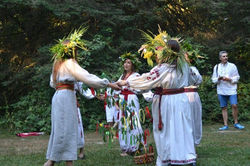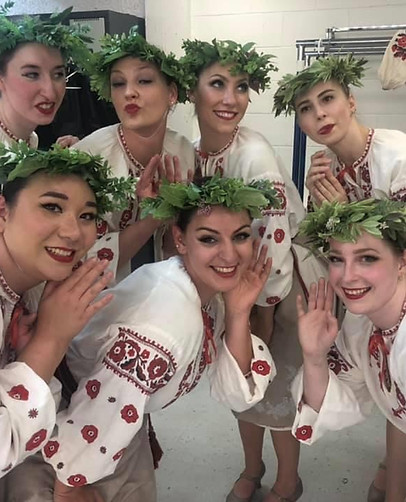Paska with Saffron

AUUC VANCOUVER-Ukrainian Cultural Center
Keeping Ukrainian-Canadian culture alive since 1918
Ivana Kupala - A Summer Celebration
Kupalo festival or Ivana Kupala, is a Slavic celebration of ancient pagan origin marking the end of the summer solstice and the beginning of the harvest (midsummer). As with many traditional holidays which were rooted in pagan beliefs and rituals, Ivana Kupala was celebrated at the changing of the seasons, following the cycle of planting and harvesting, and the cycles of the sun. With the advent of Christianity, the church tried to suppress the tradition, substituting it with the feast day of the Nativity of Saint John the Baptist (24 June), but it remained firmly part of folk ritual as the festival of Ivan (John, from Saint John) Kupalo.
 |  |
|---|---|
 |  |
 |
Images from the outdoor Ivana Kupala celebration with visiting Ukrainian folk group Rozhanytsia in BC in 2015.
Click photo above left to view the gallery
Kupalo was believed to be the god of love and of the harvest and the personification of the earth's fertility. According to popular belief, ‘Kupalo eve’ (‘Ivan's eve’) was the only time of the year when the earth revealed its secrets and made ferns bloom to mark places where its treasures were buried, and the only time when trees spoke and even moved and when witches gathered. It was also the only time of the year when free love was accepted as a celebration of fertility. On Kupala eve, unmarried young men and women gathered outside the village in the forest or near a stream or pond. There they built ‘Kupalo fires’—a relic of the pagan custom of bringing sacrifice—around which they performed ritual dances and sang ritual songs. They leaped over the fires, bathed in the water (an act of purification), and played physical games with obviously sexual connotations. The fires were also used to burn herbs gathered in the previous year and various items of no further use, particularly those that had been blessed with holy water and could therefore not be discarded by normal means. The fires were never extinguished, but were always allowed to smolder out. On Kupalo eve, female participants wore scented herbs and flowers to attract the males and adorned their hair with garlands of freshly cut flowers. Later they divined their fates according to what happened to the garlands which they had sent flowing on the water.


Above and Left: Dovbush Dancers wearing Ivana Kupala costumes and hand-made wreaths. The dancers backstage preparing to perform Nich Na Ivana Kupala.
To watch Dovbush's 2019 BC Ukrainian Cultural Festival performance click here: Nich Na Ivana Kupala.

An anthropomorphic effigy of Kupalo or a decorated sapling representing him was burned, drowned, buried, or torn apart and scattered in the fields as a symbol of the impending decline in the earth's fertility. In some regions Kupalo was represented by a wheel laced with dry grasses or straw, which was set on fire and rolled down a hill as a symbol of the declining life-giving powers of the sun after the solstice. The representation of Kupalo was frequently associated with Kostrub, the pagan god of winter, or with Marena, the goddess of spring.
Magical properties were ascribed to the plants and herbs gathered on Kupalo eve. It was believed that such herbs could protect one from the evil forces of nature and even cure illnesses in humans and animals. On the morning of the day of Ivana Kupala, young girls washed themselves with the dew that had fallen on Kupalo eve, which they collected in a bowl left outside overnight, and ran barefoot through the bedewed fields in the belief that doing so would accelerate their opportunity to get married. The sick would roll naked in the dewy meadows in the belief that this action would help them get well, and farmers would run their cattle through such meadows in the belief that this routine would prevent disease.
More information about Ivana Kupala celebrations can be found here:
Ivan Kupala Day
Rituals and Romance: Ivan Kupala in Ukraine
Music links:
Facebook: Gerdan Theatre
source: Ukrainian Dance World, posted June 22, 2017
Find all our Digital Updates here:





